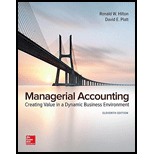
Laredo Leather Company manufactures high-quality leather goods. The company’s profits have declined during the past nine months. In an attempt to isolate the causes of poor profit performance, management is investigating the manufacturing operations of each of its products.
One of the company’s main products is leather belts. The belts are produced in a single, continuous process in the Dallas Plant. During the process, leather strips are sewn, punched, and dyed. The belts then enter a final finishing stage to conclude the process. Labor and
The leather belts produced at the Dallas Plant are sold wholesale for $9.95 each. Management wants to compare the current
The work-in-process inventory consisted of 400 partially completed units on October 1. The belts were 25 percent complete as to conversion. The costs included in the inventory on October 1 were as follows:

During October 7,600 leather strips were placed into production. A total of 7,000 leather belts were completed. The work-in-process inventory on October 31 consisted of 1,000 belts, which were 50 percent complete as to conversion.
The costs charged to production during October were as follows:

Required:
In order to provide cost data regarding the manufacture of leather belts in the Dallas Plant to the top management of Laredo Leather Company, compute the following amounts for the month of October.
- 1. The equivalent units for material and conversion.
- 2. The cost per equivalent unit of material and conversion.
- 3. The assignment of production costs to the October 31 work-in-process inventory and to goods transferred out.
- 4. The weighted-average unit cost of leather belts completed and transferred to finished goods. Comment on the company’s cost per belt used for planning and control.
- 5. Laredo Leather Company’s production manager, Jack Murray, has been under pressure from the company president to reduce the cost of conversion. In spite of several attempts to reduce conversion costs, they have remained more or less constant. Now Murray is faced with an upcoming meeting with the company president, at which he will have to explain why he has failed to reduce conversion costs. Murray has approached his friend, Jeff Daley, who is the corporate controller, with the following request: “Jeff, I’m under pressure to reduce costs in the production process. There is no way to reduce material cost, so I’ve got to get the conversion costs down. If I can show just a little progress in next week’s meeting with the president, then I can buy a little time to try some other cost-cutting measures I’ve been considering. I want you to do me a favor. If we raise the estimate of the percentage of completion of October’s inventory to 60 percent, that will increase the number of equivalent units. Then the unit conversion cost will be a little lower.” By how much would Murray’s suggested manipulation lower the unit conversion cost? What should Daley do? Discuss this situation, citing specific ethical standards for managerial accountants.
Want to see the full answer?
Check out a sample textbook solution
Chapter 4 Solutions
Managerial Accounting: Creating Value in a Dynamic Business Environment
- Cullumber Company uses a job-order cost system in each of its three manufacturing departments. Manufacturing overhead is applied to jobs on the basis of direct labour cost in Department D, direct labour hours in Department E, and machine hours in Department K. In establishing the predetermined overhead rates for 2022, the following estimates were made for the year. Department D E K Manufacturing overhead $1,280,000 $1,500,000 $840,000 Direct labour costs $1,600,000 $1,312,500 $472,500 Direct labour hours 105,000 125,000 42,000 Machine hours 420,000 525,000 120,000 The following information pertains to January 2022 for each manufacturing department. Department D E K Direct materials used Direct labour costs $147,000 $132,300 $81,900 $126,000 $115,500 $39,375 Manufacturing overhead incurred $103,950 $128,600 $73,950 Direct labour hours 8,400 11,550 3,675 Machine hours 35,700 47,250 10,380 Your answer is partially correct. Calculate the predetermined overhead rate for each department.…arrow_forwardGeneral Accounting Questionarrow_forwardWhat is the cost of the unsold merchandise on these financial accounting question?arrow_forward
- What are the proceeds to Brighton on these financial accounting question?arrow_forwardBigco Corporation is one of the nation's leading distributors of food and related products to restaurants, universities, hotels, and other customers. A simplified version of its recent income statement contained the following items (in millions). Cost of sales es Interest expense Income taxes Net earnings Sales Earnings before income taxes Selling, general, and administration expense Other revenues Total expenses (excluding income taxes) Total revenues $ 11,601 249 39 1,378 16,330 1,627 3,493 430 15,133 16,760 Prepare an income statement for the year ended June 30, current year. (Hint: First order the items as they would appear on the income statement and then confirm the values of the subtotals and totals.) Note: Enter your answers in millions rather than in dollars (for example, 5,000 million should be entered as 5,000 rather than 5,000,000). Revenues: Total revenues Expenses: BIGCO CORPORATION Income Statement (in millions) $ 0arrow_forwardNeed help with this general accounting questionarrow_forward
 Managerial AccountingAccountingISBN:9781337912020Author:Carl Warren, Ph.d. Cma William B. TaylerPublisher:South-Western College Pub
Managerial AccountingAccountingISBN:9781337912020Author:Carl Warren, Ph.d. Cma William B. TaylerPublisher:South-Western College Pub Principles of Cost AccountingAccountingISBN:9781305087408Author:Edward J. Vanderbeck, Maria R. MitchellPublisher:Cengage Learning
Principles of Cost AccountingAccountingISBN:9781305087408Author:Edward J. Vanderbeck, Maria R. MitchellPublisher:Cengage Learning Accounting Information SystemsAccountingISBN:9781337619202Author:Hall, James A.Publisher:Cengage Learning,
Accounting Information SystemsAccountingISBN:9781337619202Author:Hall, James A.Publisher:Cengage Learning, Cornerstones of Cost Management (Cornerstones Ser...AccountingISBN:9781305970663Author:Don R. Hansen, Maryanne M. MowenPublisher:Cengage Learning
Cornerstones of Cost Management (Cornerstones Ser...AccountingISBN:9781305970663Author:Don R. Hansen, Maryanne M. MowenPublisher:Cengage Learning



